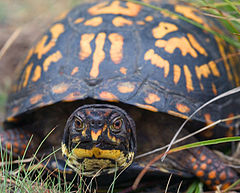|
Box turtle Box turtle is the common name for several species of turtle. It may refer to those of the genus Cuora or Pyxidea, which are the Asian box turtles, or more commonly to species of the genus Terrapene, the North American box turtles. They are largely characterized by having a shell shaped like a dome, which is hinged at the bottom, allowing the animal to close its shell tightly to escape predators. Furthermore, the two genera are very different in habitat, behavior and appearance, and are not even classified in the same family. Even though box turtles became very popular pets, their needs in captivity are complex and the capture of turtles can have serious detrimental effects on the wild population.[1] The box turtle commonly lives over twenty years, with verified cases of lifespans exceeding 40 to 50 years. There have been unverified cases of box turtles living for a hundred years and more. DietBox turtles are omnivorous. Their eagle eyes and keen sense of smell help them find foods such as snails, insects, berries, fungi, slugs, worms, flowers, fish, frogs, salamanders, various rodents, snakes, birds, eggs, among other things. During their first five to six years of life they are primarily carnivorous. Adults tend to be mostly herbivores, but do not feed on leafy greens.[2] Box turtles are known to feed on animals found dead on roadways, victims of being struck by a car or other rolling vehicle.[citation needed] Hatchlings and young turtles need more protein and prefer a carnivorous diet, to which, as they grow, they incorporate more and more plants.[1] ResearchA recent study conducted by Davidson College revealed, among other things, that a box turtle can make sounds with its jaws that exceed 75 dB. This sound can be used to scare away predators and even also as some kind of mating call. [citation needed] MatingWhile it appears that most matings of Terrapene carolina occur in one-on-one encounters, there are occasions when two males will compete for access to the same female. These encounters, which almost never amount to mortal combat, consist of head-butting, shoving, and perhaps attempts to overturn the other. It is presumed that eventually one of the males exhausts himself and withdraws from the field while the other gains access to the female. Mating occurs during nesting season beginning in the late boreal spring and ceasing at the end of the summer months.[3] Preservation  Asian box turtles are in serious danger of extinction in their habitat because they are part of the food base of many Asian countries such as China, where they are captured for local food markets despite captive breeding farms. North American box turtles, on the other hand, are endangered by habitat destruction. The forests converted to farmland greatly reduced the number of turtles in many states. The remaining land is often fragmented with highways and urban projects, destroying the animals' habitat. In an attempt to cross man-made additions, turtles are often killed by cars, animals, and other hazards. They are also facing population decline from a necrotizing bacterial infection first found in this species April 2011.[4] Another serious treatment of these animals in North America is the capture and sale of hatchling box turtles from the wild. A 3-year study conducted in Texas indicated that more than 7000 box turtles were taken from the wild for commercial trade. A similar study in Louisiana found that over a 41-month period, about 30,000 box turtles were taken from the wild for resale. Once captured, the turtles are often kept in poor conditions, in which more than half die. Those that live long enough to be sold usually suffer from conditions such as malnutrition, dehydration, and infection.[5][6] Indiana and many other states created strict laws against the collection of hatchling turtles from the wild. In many states it is illegal to keep them without a special permit. Collecting wild-hatched box turtles can cause irreversible damage to populations, because these turtles have a low reproductive rate, as they take a long time to find a mate. Most turtle and sea-turtle societies do not recommend the use of turtles as pets for young children despite their popularity as such. Box turtles are easily stressed if touched excessively and require more care than is generally thought. Box turtles can be easily injured by dogs and cats so special care must be taken to protect them from household pets and neighborhood animals. Box turtles require an enclosed outdoor location, consistent sun exposure and a varied diet. Without this, a turtle's growth can be stunted and its immune system weakened. Finding box turtles in the wild and taking them as pets, even for a short period, can have detrimental effects. Box turtles want to stay within the area where they were hatched. If one is moved more than half a mile from its territory, it may not find its way back, but may spend years searching for it. This exposes the animal to danger and also disrupts the breeding cycle of which it would otherwise have been a part. While box turtles are very popular as pets, it is important that they are preserved in the right matter. Keeping them in a more northern area where they can survive the best in ecological and physiological factor to not damage their way of living.[7] TaxonomyNorth American box turtles Family EmydidaeGenus Terrapene
Asian box turtles Family GeoemydidaeGenus Cuora
Genus Pyxidea
See alsoReferences
External links |